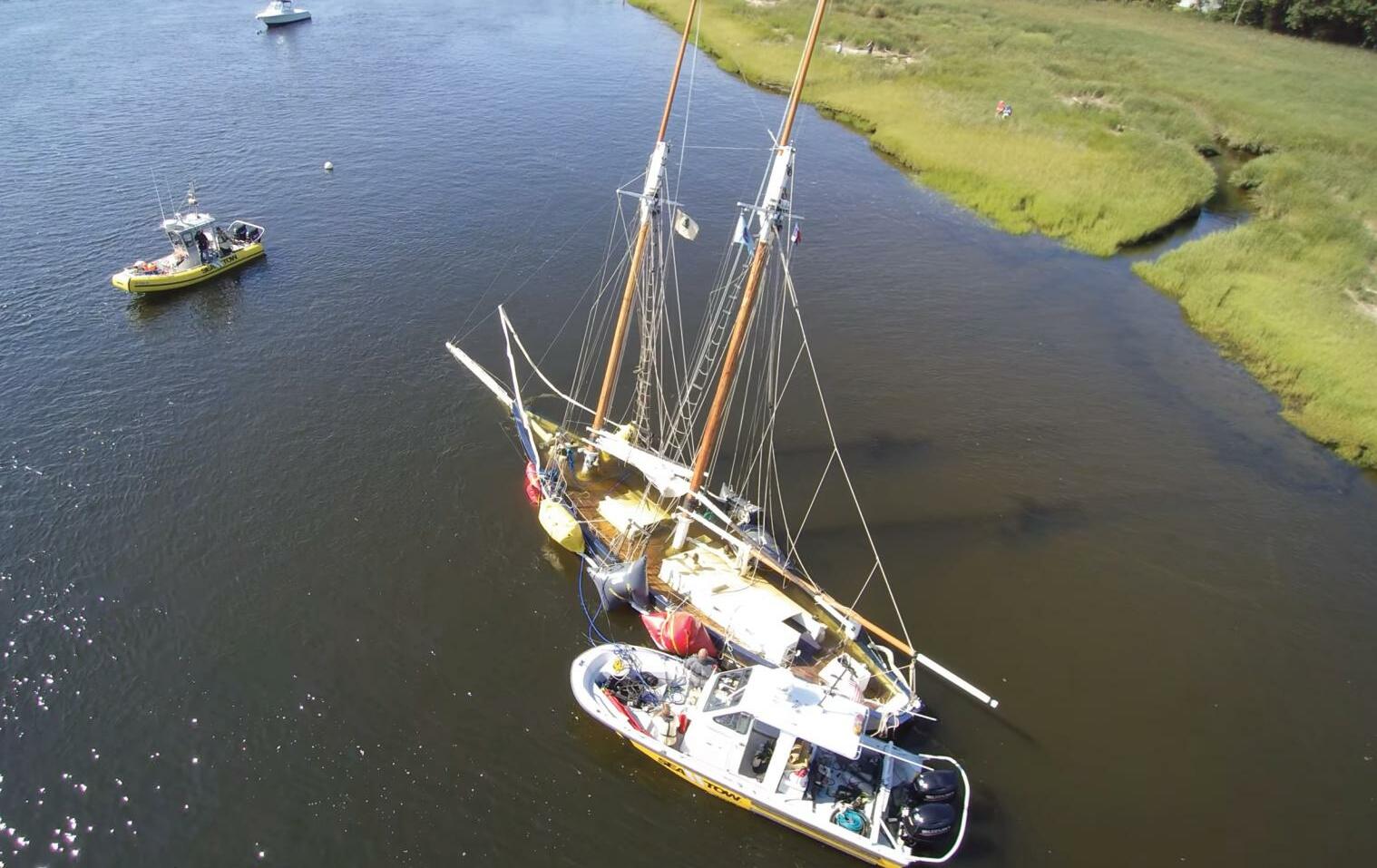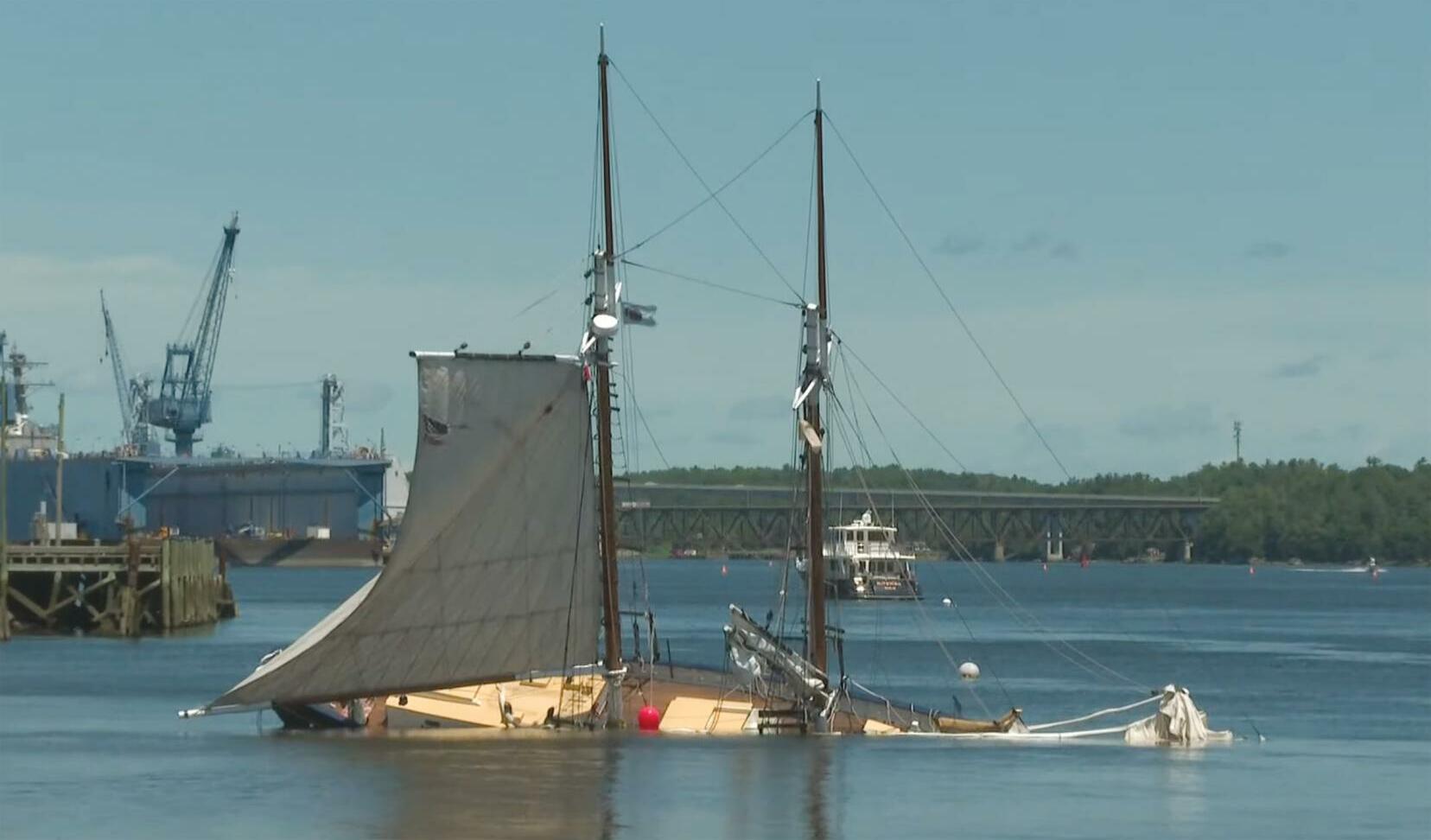
9 minute read
Rolling on the River
The Maine Maritime Museum’s schooner MARY E suffered a knockdown on the Kennebec River this summer, but it will be months before we know what caused the newly-rebuilt vessel to founder
On July 30, the Mary E, a recently-rebuilt schooner belonging to the Maine Maritime Museum in Bath, was knocked down while on a public sail in the Kennebec River. The schooner did not right herself, but did not sink, remaining on her beam ends as 18 people — 15 passengers and the crew — ended up perched on the hull or in the cold water.
Advertisement
Rapid response by local firefighters, Sea Tow, and passers-by on the river led to the successful rescue of everyone on board. Three people were taken to a hospital, Coast Guard officials said, although nobody was seriously injured and the worst diagnosis was mild hypothermia.
Neither the Coast Guard or the Maine Maritime Museum was willing to speculate on what caused the knockdown. In a written release, the Museum stated only “The vessel heeled over and some of the passengers ended up in the water. Life jackets were provided to all passengers.”
“It tilted more and more,” passenger Dr. Peter Nordlander told News Center Maine. “The wind increased. The boat tilted more and more, very slowly. You first saw water coming in from the railings.”
Video footage by Nordlander, aired by News Center Maine, provided more clues. The skies that afternoon were partly sunny, and although it was clearly a blustery day on the river, the footage does not show alarming wind velocity or whitecaps either before the knockdown, when Nordlander’s wife is shown helping to raise the mainsail, or afterwards, when passengers are shown on the hull and in the water, calmly awaiting rescue.
The mainsail and staysail appear to have been set at the time of the knockdown; the foresail did not appear to be set; the mainsail did not appear to be reefed. No damage to the hull, sails, or rig was visible in the footage.
The Nordlanders praised the crew and the first responders, said the incident shouldn’t dissuade people from taking the cruise in the future, and donated their refunded ticket price back to the Museum.
There was speculation online that the knockdown might have been precipitated by the schooner touching bottom, but this was not mentioned by either the USCG or the Museum.
The Mary E remained afloat but awash after the incident. She was towed to shallow water at the edge of the river and on August 1 was righted, pumped out, and towed to the Robinhood Marine Center in Georgetown, Maine.
“It is the Museum’s hope that we will get the Mary E back sailing as soon as the work is done to assure the vessel is safe to carry passengers,” stated a Museum release.
“Mary E is the last surviving schooner built on the Kennebec River and Maine Maritime Museum is committed to returning it to its mission of carrying our guests on educational and scenic sails on the Kennebec River.”

Still from drone footage of the recovery effort
Courtesy Frank Bedell
Many owners, several rebuilds
Built in Bath in 1906 by Thomas E. Hagan, the Mary E is on the National Register of Historic Places. Originally engineless, she was used as a fishing vessel and cargo carrier out of Block Island for many years and later as a gas-powered dragger out of Gloucester, Massachusetts.
Clarence W. Leveille purchased her in 1950. Leveille used her for net fishing out of Gloucester, increasing her crew and replacing her gas engine with a diesel. By 1960 she was abandoned, and she sank in a Thanksgiving Day hurricane in 1963 in Lynn Harbor, Mass.
Two years later, William R. Donnell II of Bath, knowing his great-grandfather had been an associate of Hagan, purchased the hulk and raised it. He brought it to Bath and began a two-year renovation on the grounds of what is now the Maine Maritime Museum. After this restoration, the schooner worked as a passenger vessel out of Rockland, Maine, and then out of South Street Seaport in New York City.
The Museum’s website states, “It is believed that the Mary E was the first historic schooner to be certified as a USGC passenger vessel and paved the way for the entire Maine Windjammer Fleet to become likewise certified vessels.”
In 1971, the vessel was sold to Robert Morse of Morse Marine in Boothbay Harbor. Later she was sold to jazz musician Teddy Charles, who sailed her to New York where
she was one of the first schooners sailing out of South Street Seaport. In 1990, Captain Charles moved her to Greenport, NY where she sailed as a passenger vessel and traveled to Key West, Florida in the winters.
In 2006, Matt Culen purchased her and began a major restoration effort with Captain Eric Van Dormolen in collaboration with the Long Island Maritime Museum in Greenport. He later moved her to the Connecticut River Maritime Museum docks, and had been running river tours there every summer.
Return to Bath
The Museum acquired the Mary E in 2017 and the vessel was restored on the Museum campus by Andros Kypragoras from 2017 to 2018. Shipwrights cut off the transom, reframed the last 12 feet of the vessel on both the port and starboard side, and replaced almost all of the framing and planking above the waterline. Other parts of the restoration included installation of a new engine and a redesigned rig. Kypragoras did not respond to our request for an interview.
Mary E was relaunched in 2018 and certified to carry passengers, although it is not known if a new stability letter was required. According to the Museum's website, the Mary E was scheduled for a 2.5-hour river sail the afternoon of July 30. She would have sailed past the site of Hagan’s yard, where Mary E was originally built, as well as the Bath Iron Works. While there are some shoal areas in that section of the river, they are buoyed and the navigation is not considered difficult.

Still from video aired by News Center Maine
Used by permission
Given that the schooner’s captain at the time, J.B. Smith, is a vastly experienced sailor and a well-respected figure in sail-training circles, speculation has focused on the stability characteristics of the rebuilt vessel. Neither the USCG or the Museum would discuss the current stability characteristics of the schooner, pending the results of the USCG investigation. A comparison of the original design and rig with the current configurations would, of course, be of interest.
Photos of the rebuilt vessel underway do show quite a bit of bottom paint above the waterline, suggesting a boat that was riding high and light.
Reportedly the Mary E did have watertight compartments, but not external ballast. While external ballast might have prevented the knockdown, it also might have caused the swamped vessel to sink instead of remaining awash.
Potential lawsuits
Although no deaths or serious injuries resulted from the July 30 incident, it is widely anticipated that the well-funded Maine Maritime Museum will be the target of lawsuits from passengers claiming personal injury, pain and suffering, etc.
In late August, a month after the knockdown, the Museum’s attorney, William H. Welte, filed a complaint looking to stave off such lawsuits, requesting “exoneration from or limitation of liability” in U.S. District Court in Portland.
Welte wrote that the Museum “used due diligence to make the subject vessel seaworthy and safe" and that it was “properly equipped and supplied, and in all respects seaworthy and fit for the services for which she was engaged.”
Welte wrote that he has reason to believe lawsuits will be filed, and that the claims “do or will greatly exceed” what the Museum claims is the $150,000 post-casualty value of the Mary E. The museum denies causing or contributing to any such injury.
Coast Guard Reaction
The USCG investigation will probably not be concluded and released until the late winter or early spring.
While the process takes years, the Coast Guard does
react to marine incidents. The loss of the John F. Leavitt eventually led to new standards for wooden boat-building; the dismasting of sailing excursion vessels in Hawaii and Key West led to increased attention to rig inspection; and the well-publicized fire aboard the California dive boat Conception, which claimed 34 lives, has already led to additional inspections aboard vessels with overnight accommodations.

Still from video aired by News Center Maine
Used by permission
Most recently, the USCG has introduced “Risk-Based Inspections” stipulating additional inspections for 870 vessels — about 12% of the small-passenger fleet — deemed risky due to “compliance history, number of passengers carried, vessel type, vessel age, route, and history of peer vessels.”
Speculating that the Mary E knockdown will be blamed on insufficient stability characteristics that are the incremental result of many years of modifying and rebuilding an original vessel — a vessel that sailed successfully for over a century — how might the Coast Guard’s inspection department react to that news? These are not recommendations, merely possibilities, but:
The USCG could insist on a new stability test and letter for any vessel undergoing significant changes to her hull or rig;
The USCG could re-inspect and re-certify vessels built before a certain year, particularly those without subdivision or external ballast;
The USCG could issue guidance that allows sailing only in the absence of NOAA watches, warnings, or alerts;
The USCG could issue guidance as to reduction of sail in certain conditions, and could add reefing and sail-handling drills to underway inspections;
Valid objections can be raised to all those potential reactions. They would cost boat operators time and money. They would not guarantee safety. There will always be resistance — and rightly so — to any regulations that take decision-making away from captains and operators on the scene. Forecasts are frustratingly inaccurate, especially when it comes to wind strength and direction.
All of these reactions do have the potential to increase passenger safety. However, safety is not the guiding principle of sail training. A small, calculated, but finite amount of risk is necessary for sail-training to have its life-changing impact.
Whether or not day-sails like the ones conducted by the Mary E qualify as “sail training” or should be held to higher standards more appropriate to passenger vessels, where there is little or no expectation of passengers getting involved in operations, is another question. ❂
The Maine Maritime Museum has declined to discuss the incident until the USCG report is released. The USCG likewise will not comment until their investigation is concluded.


